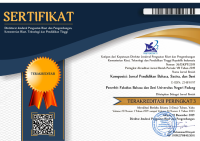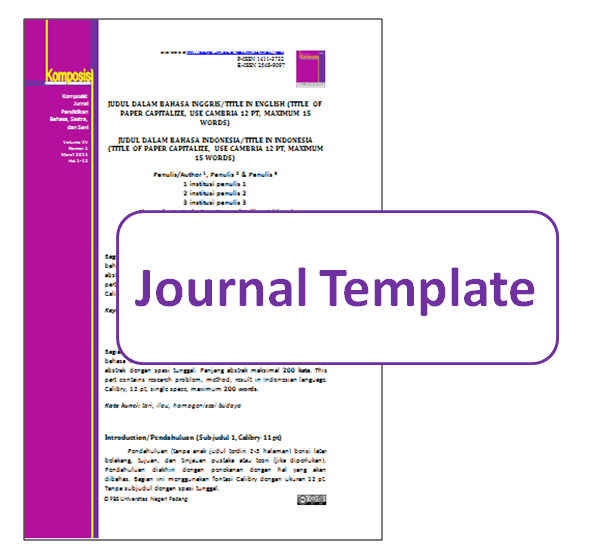Dimensi Budaya dalam Syair Sidi Djamadi
 ), Fitri Merawati(2), Indah Arohmawati(3),
), Fitri Merawati(2), Indah Arohmawati(3), (1) Universitas Ahmad Dahlan
(2) Universitas Ahmad Dahlan
(3) Universitas Ahmad Dahlan
 Corresponding Author
Corresponding Author
Copyright (c) 2020 Komposisi: Jurnal Pendidikan Bahasa, Sastra, dan Seni
DOI : https://doi.org/10.24036/komposisi.v21i2.110043
Full Text:
 Language : en
Language : en
Abstract
Syair Sidi Djamadi is one of the old literary legacies of the Minangkabau which contains interesting lessons and knowledge to know. One of the things that can be expressed in these verses is the cultural dimension. The purpose of this study is to describe the cultural dimension in Sidi Djamadi's poetry. The research method used is descriptive qualitative. The research object is the cultural dimension and the research subject of Sidi Djamadi's poetry. The results of this study indicate that Sidi Djamadi's poetry is not only identical with religious advice and advice, but also contains a cultural dimension that can describe the Minangkabau people. The dominant cultural dimension is the uncertainty / avoidance aspect. This illustrates that the Minangkabau people tend to choose in safe / normal conditions rather than do something that is not clear or its usefulness is not yet known. Apart from that, the cultural dimensions that were found to be dominant were holding fast, uncertainty, avoiding and stopping the bad.
Keywords
References
Armia, C. (2002). Pengaruh Budaya Terhadap Efektivitas Organisasi: Dimensi Budaya Hofstede. Jurnal Akuntansi Dan Auditing Indonesia, 6(1), 103–117. https://media.neliti.com/media/publications/75468-none-747bde56.pdf
Brislin, R. (2000). Understanding culture’s influence on behavior. Harcourt.
Dayakisni, T. dan Yuniardi, S. (2003). Psikologi lintas budaya. UMM Press.
Dewan Redaksi. (2013). Ensiklopedi Sastra Indonesia. Titian Ilmu.
Fithri, W. (2014). Kekhasan Hermeneutika Paul Ricoeur. Jurnal Tajdid, 17(2), 187–211.
Fithri, W. (2017). Badoncek dalam Tradisi Masyarakat Padang Pariaman Sumatera Barat. Majalah Ilmu Pengetahuan Dan Pemikiran Keagamaan Tajdid, 20(2), 11–15.
Hofstede, G. (1994). Cultures and organizations: software of the mind. Harper-Collins.
Indraningsih. (2011). Hermeneutika Paul Ricoeur dan Penerapannya pada Pemaknaan Simbol dalam Roman ‘Rafilus’ Karya Budi Darma. Jurnal Filsafat, 21(2), 119–133.
Kirkman, B.L., Lowe, K.B. dan Gibson, C. B. (2006). A quarter century of Culture’s Consequences: a review of empirical research incorporating Hofstede’s cultural values framework. Journal of International Business Studies, 37(1), 285–320.
Moleong, L. J. (2005). Metodologi penelitian kualitatif. Remaja Rosda Karya.
Purwanto, W. E., & Wulandari, Y. (2019). LIBASUTTAQWA IN THE POEM OF SIDI DJAMADI: A HERMENEUTIC STUDY OF PAUL RICOEUR. Komposisi: Jurnal Pendidikan Bahasa, Sastra, Dan Seni, XX(2), 99–111.
Sastrosupono, M. . (1982). Menghampiri Kebudayaan. Penerbit Alumni.
Yasin, D. M. (2016). Digitalisasi Dan Deskripsi Naskah Kuno Sebagai Upaya Memperkokoh Kedaulatan Indonesia : Studi Kasus Naskah Al- Mutawassimīn. Lembagakeris, 2(1), 24–33.
Zakaria. (2016). Dakwah Sufistik Hamzah Fansuri (Telaah Substansi Syair Perahu). Al-Bayan, 22(33), 17–28.
 Article Metrics
Article Metrics
 Abstract Views : 409 times
Abstract Views : 409 times
 PDF Downloaded : 66 times
PDF Downloaded : 66 times
Refbacks
- There are currently no refbacks.
Copyright (c) 2020 Komposisi: Jurnal Pendidikan Bahasa, Sastra, dan Seni

This work is licensed under a Creative Commons Attribution-NonCommercial 4.0 International License.











